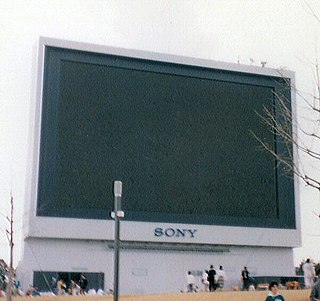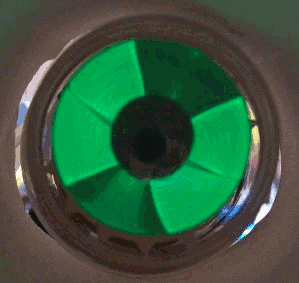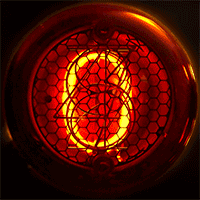 W
WThe 7JP4 is an early black and white or monochrome cathode ray tube. It was a popular type used in late 1940s low cost and small table model televisions. The 7JP4 has a 7" diameter round screen which was often partially masked. Unlike later electromagnetically deflected TV tubes, the 7JP4 is electrostatically deflected like an oscilloscope tube.
 W
WThe cathode-ray tube (CRT) is a vacuum tube that contains one or more electron guns and a phosphorescent screen, and is used to display images. It modulates, accelerates, and deflects electron beam(s) onto the screen to create the images. The images may represent electrical waveforms (oscilloscope), pictures, radar targets, or other phenomena. CRTs have also been used as memory devices, in which case the visible light emitted from the fluorescent material is not intended to have significant meaning to a visual observer.
 W
WCharactron was a U.S. registered trademark of Consolidated Vultee Aircraft Corporation (Convair) for its shaped electron beam cathode ray tube. Charactron CRTs performed functions of both a display device and a read-only memory storing multiple characters and fonts. The similar Typotron was a U.S. registered trademark of Hughes Aircraft Corporation for its type of shaped electron beam storage tube with a direct-view bistable storage screen.
 W
WA Crookes tube is an early experimental electrical discharge tube, with partial vacuum, invented by English physicist William Crookes and others around 1869-1875, in which cathode rays, streams of electrons, were discovered.
 W
WIn electronics, a Dekatron is a gas-filled decade counting tube. Dekatrons were used in computers, calculators and other counting-related products during the 1950s and 1960s. "Dekatron," now a generic trademark, was the brand name used by Ericsson Telephones Limited (ETL), of Beeston, Nottingham.
 W
WA Geissler tube is an early gas discharge tube used to demonstrate the principles of electrical glow discharge, similar to modern neon lighting. The tube was invented by the German physicist and glassblower Heinrich Geissler in 1857. It consists of a sealed, partially evacuated glass cylinder of various shapes with a metal electrode at each end, containing rarefied gasses such as neon, argon, or air; mercury vapor or other conductive fluids; or ionizable minerals or metals, such as sodium. When a high voltage is applied between the electrodes, an electrical current flows through the tube. The current dissociates electrons from the gas molecules, creating ions, and when the electrons recombine with the ions, the gas emits light by fluorescence. The color of light emitted is characteristic of the material within the tube, and many different colors and lighting effects can be achieved. The first gas-discharge lamps, Geissler tubes were novelty items, made in many artistic shapes and colors to demonstrate the new science of electricity. In the early 20th century, the technology was commercialized and evolved into neon lighting.
 W
WA jumbotron, sometimes referred to as jumbovision, is a video display using large-screen television technology. The original technology was developed in the early 1980s by Mitsubishi Electric and Sony, which coined JumboTron as a brand name in 1985. Mitsubishi Electric sold their version of the technology as Diamond Vision. It is typically used in sports stadiums and concert venues to show close up shots of an event, as well as outdoor public places.
 W
WA magic eye tube or tuning indicator, in technical literature called an electron-ray indicator tube, is a vacuum tube which gives a visual indication of the amplitude of an electronic signal, such as an audio output, radio-frequency signal strength, or other functions. The magic eye is a specific type of such a tube with a circular display similar to the EM34 illustrated. Its first broad application was as a tuning indicator in radio receivers, to give an indication of the relative strength of the received radio signal, to show when a radio station was properly tuned in.
 W
WA neon lamp is a miniature gas discharge lamp. The lamp typically consists of a small glass capsule that contains a mixture of neon and other gases at a low pressure and two electrodes. When sufficient voltage is applied and sufficient current is supplied between the electrodes, the lamp produces an orange glow discharge. The glowing portion in the lamp is a thin region near the cathode; the larger and much longer neon signs are also glow discharges, but they use the positive column which is not present in the ordinary neon lamp. Neon glow lamps were widely used as indicator lamps in the displays of electronic instruments and appliances.
 W
WNimo was the trademark of a family of very small cathode ray tube (CRTs) manufactured by Industrial Electronics Engineers around mid-1960s, with ten electron guns with stencils which shaped the electron beam as digits.
 W
WA Nixie tube, or cold cathode display, is an electronic device used for displaying numerals or other information using glow discharge.
 W
WGeneral Electric's Porta-Color was the first "portable" color television introduced in the United States in 1966.
 W
WStorage tubes are a class of cathode-ray tubes (CRTs) that are designed to hold an image for a long period of time, typically as long as power is supplied to the tube.
 W
WA teltron tube (named for Teltron Inc., which is now owned by 3B Scientific Ltd.) is a type of cathode ray tube used to demonstrate the properties of electrons. There were several different types made by Teltron including a diode, a triode, a Maltese Cross tube, a simple deflection tube with a fluorescent screen, and one which could be used to measure the charge-to-mass ratio of an electron. The latter two contained an electron gun with deflecting plates. The beams can be bent by applying voltages to various electrodes in the tube or by holding a magnet close by. The electron beams are visible as fine bluish lines. This is accomplished by filling the tube with low pressure helium (He) or Hydrogen (H2) gas. A few of the electrons in the beam collide with the helium atoms, causing them to fluoresce and emit light.
 W
WTrinitron is Sony's brand name for its line of aperture-grille-based CRTs used in television sets and computer monitors. One of the first truly innovative television systems to enter the market since the 1950s, the Trinitron was announced in 1968 to wide acclaim for its bright images, about 25% brighter than common shadow mask televisions of the same era. Constant improvement in the basic technology and attention to overall quality allowed Sony to charge a premium for Trinitron devices into the 1990s.
 W
WA vacuum fluorescent display (VFD) is a display device once commonly used on consumer electronics equipment such as video cassette recorders, car radios, and microwave ovens. LCDs, OLED displays and LED segment displays have now largely replaced VFDs.